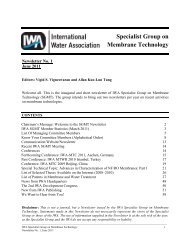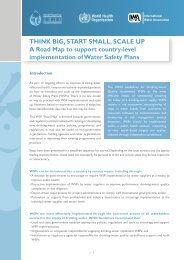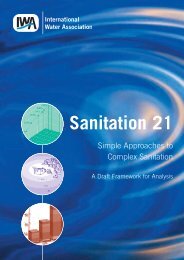AdApting urbAn wAter systems to climAte chAnge - IWA
AdApting urbAn wAter systems to climAte chAnge - IWA
AdApting urbAn wAter systems to climAte chAnge - IWA
You also want an ePaper? Increase the reach of your titles
YUMPU automatically turns print PDFs into web optimized ePapers that Google loves.
32 Adapting urban water <strong>systems</strong> <strong>to</strong> climate change<br />
A handbook for decision makers at the local level<br />
Section 2<br />
A strategic planning framework for adaptation<br />
33<br />
This section does not provide<br />
information on how <strong>to</strong><br />
establish, facilitate or evaluate<br />
a stakeholder involvement<br />
process. More detailed<br />
guidance on these <strong>to</strong>pics can<br />
be found in Module 2 of the<br />
SWITCH Training Kit (ICLEI<br />
European Secretariat, 2011).<br />
It should be noted that the stakeholder process does not replace but rather complements<br />
the governance of the urban water system. The actual power of decision making – and<br />
thus the accountability – for performing good water services still lies with the public and<br />
private entities that have an official mandate for managing water. An effective stakeholder<br />
process will however ensure that important decisions are taken in consensus with all key<br />
ac<strong>to</strong>rs and that these in turn develop a sense of responsibility and willingness <strong>to</strong> support<br />
the official entities within the limitations of their own capacities. In order <strong>to</strong> make integration<br />
a reality, stakeholders play a varying but continuous role throughout the strategic<br />
planning process. Early involvement is advisable <strong>to</strong> gain and strengthen their ownership<br />
and thus their motivation right from the beginning. Stakeholders are identified as part of<br />
the baseline assessment, ideally at the beginning of that process, so that they can also<br />
give their input <strong>to</strong> the vital information collection exercise.<br />
© Anne-Claire Loftus<br />
Evaluating adaptation options through a participa<strong>to</strong>ry process<br />
Hermosillo, Mexico, was the setting of a participa<strong>to</strong>ry exercise aimed at defining, evaluating<br />
and prioritising adaptation options. A preliminary list of adaptation options was generated<br />
based on informal interviews with a range of stakeholders; these options were then<br />
discussed at a formal stakeholder workshop which resulted in the choice of five options. A<br />
research team then <strong>to</strong>ok on the detailed analysis of the proposals, the results of which were<br />
debated during another workshop. Participants proposed evaluation criteria, qualitatively<br />
assessed the options against these, and were asked <strong>to</strong> prioritise the options both in terms of<br />
how they met current water challenges and of how they would help cope with two possible<br />
future climate scenarios.<br />
The pilot project succeeded in introducing the issue of climate change in<strong>to</strong> <strong>to</strong> the already<br />
heated debate surrounding the city’s water resources. Many decision-making agencies were<br />
represented in the stakeholder workshops, hopefully sowing the seeds for the incorporation<br />
of climate change adaptation in<strong>to</strong> policies. However, the process was hampered by the<br />
limited participation of stakeholders from the agricultural sec<strong>to</strong>r: as the city’s main water<br />
users, their participation would have been essential <strong>to</strong> build a holistic picture and reduce<br />
conflict (Eakin et al., 2007).<br />
Strategic planning that specifically includes climate<br />
change as one fac<strong>to</strong>r under consideration is likely <strong>to</strong><br />
come across certain difficulties in its involvement of<br />
stakeholders – these can be addressed through good<br />
facilitation and knowledge sharing (Gardner, Dowd,<br />
Mason & Ashworth, 2009).<br />
• Gaps in knowledge: Providing information can help<br />
address lack of understanding and misconceptions.<br />
• Uncertainty: Acknowledging uncertainty is vital, as<br />
is presenting climate change adaptation as a response<br />
<strong>to</strong> risk rather than events that might or might not be<br />
occurring presently.<br />
• Scepticism: Being open about scientific work, putting the emphasis on the inherent<br />
rationality of taking a risk management approach and highlighting the co-benefits of<br />
adaptation can help overcome scepticism or at least put it aside.<br />
• Emotional reactions: The strategic planning approach, which has at its core action<br />
planning and implementation, can help surmount feelings of helplessness and encourage<br />
participation.<br />
2.3 Communicating climate change adaptation<br />
Stakeholders are central <strong>to</strong> the implementation of adaptation, and failure <strong>to</strong> adequately<br />
communicate with them about climate change can put barriers in its way. First, almost<br />
all adaptation actions will impact stakeholders <strong>to</strong> some degree, be it through a visible<br />
change or through expenditure of tax revenue. If the reasoning behind such impacts is<br />
not explained or does not resonate with stakeholders, these are likely <strong>to</strong> oppose planned<br />
projects. This can be the case for some of the technologies and options outlined in this<br />
handbook, since these are not yet widespread and are based on some concepts that can<br />
trigger preconceived notions, for example the recycling of human waste. Secondly, a lot of<br />
the flexible solutions for urban management rely heavily on decentralised solutions which<br />
can require the active support and participation of the public for their wide uptake, <strong>to</strong> a<br />
much greater degree than typical centralised water management infrastructure – green<br />
roofs and rainwater harvesting are some examples.<br />
Communicating climate change<br />
© Water and Sanitation Program at the World Bank (wsp.org)<br />
The stakeholders linked <strong>to</strong> urban<br />
water management are a disparate<br />
group, with varying levels<br />
of knowledge about water and<br />
climate change. Generally, stakeholders<br />
outside of the scientific<br />
community and of the institutions<br />
directly involved with urban water<br />
management can be presumed<br />
<strong>to</strong> have some knowledge gaps in<br />
these areas. As part of the strategic<br />
planning process, it will be<br />
necessary <strong>to</strong> communicate about<br />
such issues with these stakeholder<br />
groups.<br />
The Centre for Research on Environmental Decisions (CRED) has identified eight<br />
principles of climate change communication: knowing one’s audience, getting its<br />
attention, translating scientific data in<strong>to</strong> concrete experiences, not overusing emotional<br />
appeals, addressing uncertainties, taking advantage of the audience’s group affiliations,<br />
encouraging group participation and fostering environmentally-positive behaviour<br />
(CRED, 2009). Although it is not within the scope of this handbook <strong>to</strong> help cities define<br />
a complete climate change communication strategy, the first principle – knowing one’s<br />
audience – does merit <strong>to</strong> be reviewed in more detail.<br />
Any good marketing or communication plan should begin with an assessment of the<br />
target market or audience for the product, service or campaign. In the case of climate<br />
change, this involves assessing stakeholders’ level of knowledge of, and opinions about,<br />
climate change and adaptation. This may involve undertaking a survey on the perception<br />
of climate change among the stakeholders identified as part of the strategic planning<br />
process. Such a survey can help identify any gaps in knowledge and barriers <strong>to</strong> effective<br />
collaboration, for example in the event of widely varying and conflicting opinions between<br />
and within stakeholder groups. It may reveal that the implementation of a particular<br />
adaptation solution would need <strong>to</strong> be preceded by a public education exercise. For<br />
example, the reuse of treated wastewater effluent or the use of sewage sludge as a<br />
fertiliser can raise concerns relating <strong>to</strong> public health, which need <strong>to</strong> be addressed prior <strong>to</strong><br />
implementation.
















